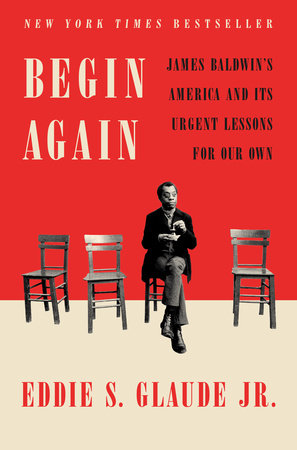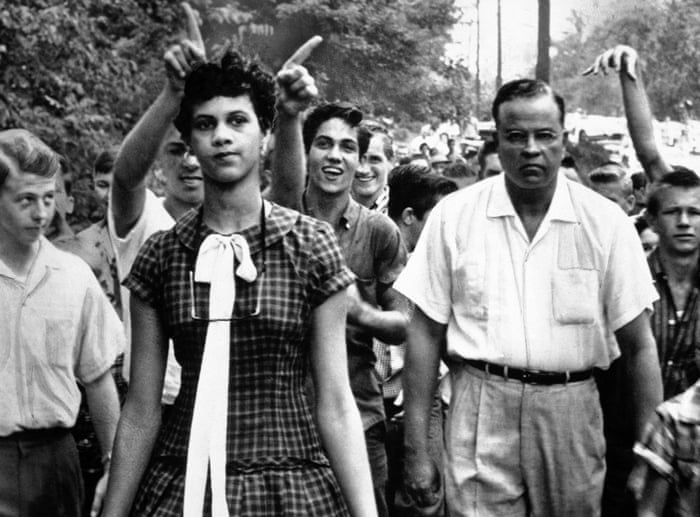“I must admit this is a strange book,” Eddie S. Glaude Jr. explains in the “Introduction” to Begin Again, explaining:
It isn’t biography, although there are moments when it feels biographical; it is not literary criticism, although I read Baldwin’s nonfiction writings closely; and it is not straightforward history, even though the book, like Baldwin, is obsessed with history. Instead, Begin Again is some combination of all three in an effort to say something meaningful about our current times. (p. xviii)
One such “something meaningful” is quite large: “A moral reckoning is upon us, and we have to decide, once and for all, whether or not we will truly be a multiracial democracy” (p. xix).

Addressing that large scope for the book, Glaude navigates James Baldwin witnessing and confronting “the lie“:
The lie is more properly several sets of lies with a single purpose. If what I have called the “value gap” is the idea that in America white lives have always mattered more than the lives of others, then the lie is a broad and powerful architecture of false assumptions by which the value gap is maintained. These are the narrative assumptions that support the everyday order of American life, which means we breathe them like air. We count them as truths. We absorb them into our character. (p. 7; see Chapter One excerpt for a full explication of “the lie”)
But as Glaude notes about his own transition form Ralph Ellison to Baldwin—”Baldwin was too personal. In contrast, Ellison remained hidden behind his elegant words and powerful insight” (p. xxiv)—another “something meaningful” is as small as an individual person, a jumbled intersection with Baldwin, Dorothy Counts:

Chapter Two, “Witness,” opens with the harrowing story or Dorothy “Dot” Counts, a Black teenager carrying the weight of integrating Harding High School in Charlotte, NC, in 1957.
“Dot walked a racist gauntlet to enter Harding High School,” Glaude details. “She made the walk for just three more days before deciding never to return” (p. 30).
The racist anger launched repeatedly at a fifteen-year-old young woman personifies the lie, but that indelible image of Dot Counts became a twisted mythology for Baldwin (even as he fumbled details and the facts of history):
[I]n No Name in the Street, [Baldwin] would start at the beginning, with the image of her amid the hatred on her first day, and use the famous photo [above] of Dorothy to justify his own decision to join the fray….
Looking back, after the deaths of Medgar Evers, Malcolm X, and Martin Luther King, Jr., the photo with all of its pathos, anguish, and pride represented for Baldwin in 1972 the demand to bear witness to what was happening in 1957 and to what had transpired since, which led to his [mistaken] recollection of it in No Name in the Street. Dot’s eyes captured the trauma of that journey. Baldwin sought to narrate what happened on the eve of a social movement that would attempt to transform the country, and to testify to that odd combination of trauma and grit, which he now knew so well, seen in a fifteen-year-old black girl’s courage that spurred him, so he believed, to leap into the fire. (p. 43)
So, why Dorothy Counts?
Glaude weaves a motif of trauma through this work, and certainly there is trauma linking Baldwin and Counts, the latter more often than not ignored by white America: “It has never been America’s way to confront the trauma directly, largely because the lie does not allow for it” (p. 46). The result, Glaude notes, is “historical gaslighting.”
That did not happen, or That did not happen that way, or That is only the past, not who we [Americans] are today—so it goes.
While Baldwin’s mythology of Counts and his charge to bear witness are a narrative of the South, it certainly has become a prescient story about all of America, especially those supporting Trump:
The white southerner had to lie continuously to himself in order to justify his world. Lie that the black people around hum were inferior. Lie about what he was doing under the cover of night. Lie that he was Christian. For Baldwin, the accumulation of lies suffocated the white southerner. (p. 49)
That was then; this is now:
We are told every day not to believe what we see happening all around us or what we feel in the marrow of our bones. We are told, for example, that Trumpism is exceptional, a unique threat to our democracy. thus view that Trump, and Trump alone, stresses the fabric of the country lets us off the hook. It feeds into the lie that Baldwin spent the majority of his life trying to convince us to confront. It attempts to explain away as isolated events what today’s cellphone footage exposes as part of our everyday experience. Exceptionalizing Trump deforms our attention…. Trump represents a reassertion of the belief that America is, and always will be, a white nation. (p. 54)
Read Glaude’s exceptional work grounded in Baldwin and you will soon learn that there is no question why Dorothy Counts.
Dorothy Counts-Scoggins Still Fighting
This picture signaled an end to segregation. Why has so little changed?
From Observer archives (2007): Dorothy Counts at Harding High, a story of pride, prejudice










